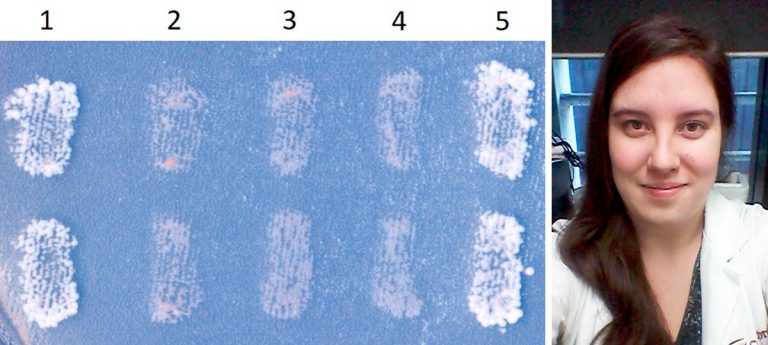Grad student Nathalie Reid is researching how proteins function

Nathalie Reid decided to pursue a career in biochemistry because the field combines her interests in biology, chemistry and mathematics.
Now, the first-year PhD candidate in the Department of Chemistry and Biochemistry is pursuing research in genetics, protein characterization, enzymology and evolutionary biology that could significantly impact how we understand certain diseases, including SIFD.
As a member of Paul Joyce’s lab, Reid looks at the relationship between tRNA nucleotidyltransferase (tRNA-NT) enzymes and Schizosaccharomyces pombe yeast. She is also the lead author of a paper recently published in Biochemical and Biophysical Research Communications. The study was co-authored by Joyce, who is her supervisor, and fellow Concordia student Judith Ngou.
I feel comfortable and supported at Concordia
How does this specific image (top left) relate to your research at Concordia?
Nathalie Reid: This is an image of a yeast colony growth assay. There are visible colonies in column one because they contain the gene coding for tRNA-NT, which is essential for growth. The lack of colonies in the second column shows how cells cannot develop when we remove this gene.
Columns three, four and five demonstrate that we need two genes from Schizosaccharomyces pombe to replace tRNA-NT activity in yeast. When either gene is on its own — like in columns three and four — no progress is evident. Column five contains both Schizosaccharomyces pombe genes and exhibits growth.
What is the hoped-for result of your project? And what impact could you see it having on people’s lives?
NR: My project aims to increase our fundamental understanding of the tRNA-NT enzymes in the yeast, Schizosaccharomyces pombe. These enzymes, usually found as a single protein in eukaryotes, are essential for the survival of all species due to their role in tRNA processing and protein synthesis.
My project focuses on developing a basic understanding of how these proteins function, as well as determining the evolutionary path that culminated in a eukaryote with two tRNA-NT genes. A fundamental knowledge of how these enzymes work may allow us to understand human diseases that develop because of the protein’s inability to function correctly.
What are some of the major challenges you face in your research?
NR: My lab has not worked with this species of yeast before. One of the biggest challenges so far has been applying commonly used techniques in my lab to this organism, and then optimizing these methods to get reliable results.
What are some of the key areas where your work could be applied?
NR: My work explores the interesting evolutionary question of why some organisms have two genes to do an activity while one gene is sufficient in most. These studies seek to understand how enzyme structure and function may ultimately be applied to disease phenotypes.
What person, experience or moment in time first inspired you to study this subject and get involved in the field?
NR: I decided to pursue biochemistry because it is a field that combined my interests in biology, chemistry and mathematics. The more I learned about this topic, the more I wanted to build a career in it.
As a member of the Institute for Co-operative Education, I gained experience at different companies, which convinced me to continue my studies at the graduate level. I began as a master’s candidate in chemistry but recently fast-tracked into Concordia’s doctoral program. Protein research remains my preferred subject.
How can interested STEM students get involved in this line of research? What advice would you give them?
NR: Opportunities for research in biochemistry are vast. Trying out different sub-disciplines can help narrow the field. At Concordia, students can volunteer or get credit by working in one of the research labs to see what captures their imagination.
Because biochemistry is related to biological systems, there is a lot of trial and error involved in carrying out experiments. Therefore, patience is also very important for those who want to pursue a career in this field.
What do you like best about being at Concordia?
NR: Concordia was my school of choice when I began my undergraduate degree in 2013. The professors are approachable, available for one-on-one meetings and respond rapidly to queries. Fellow graduate students are always helping each other when it comes to understanding a new procedure, sharing equipment or preparing for an oral presentation.
I describe Concordia as my second family because it is a place where I feel comfortable and supported. I hope to help spread this great learning environment in the years to come.
Are there any partners, agencies or other funding/support attached to your research?
NR: A Concordia University Graduate Fellowship Award partially supports my research. Paul Joyce also holds a Discovery Grant from the Natural Sciences and Engineering Research Council of Canada for this project.
Learn more about Concordia’s Department of Chemistry and Biochemistry.




